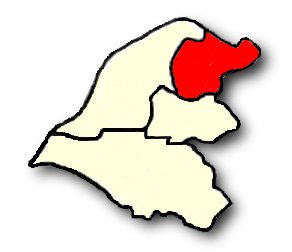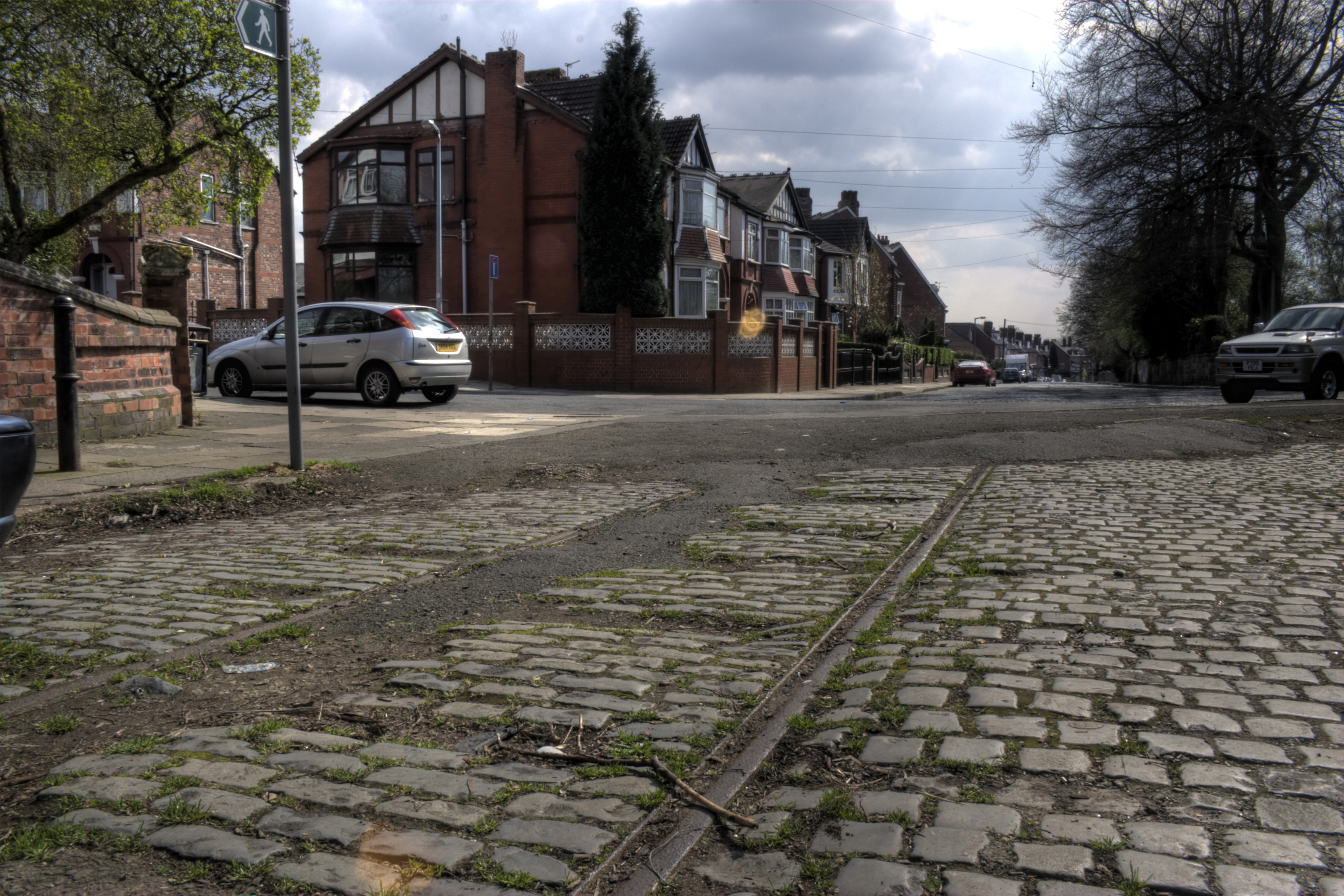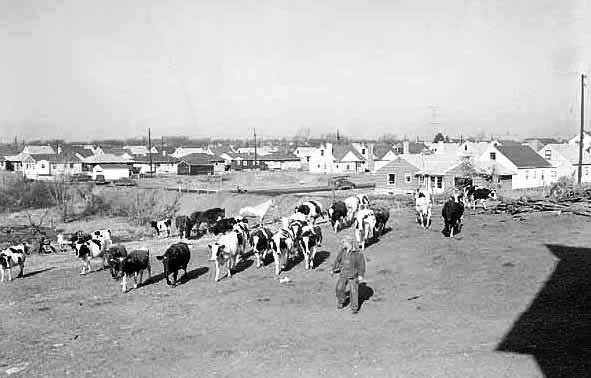|
Altrincham Line
The Altrincham Line is a tram line of the Manchester Metrolink running from Manchester to Altrincham in Greater Manchester. Originally a railway line, it was, along with the Bury Line, converted into a tramway during 1991–92, as part of the first phase of the Metrolink system. Route The line runs south-west from Manchester city centre, rising from a ramp which takes the tracks onto the streets of central Manchester, just east of stop, and then runs along a former railway viaduct, parallel to the heavy rail Manchester to Warrington and Liverpool line as far as ; just west of which the Eccles Line diverges to the north-west, and the Altrincham line runs south-west under the railway through an underpass. Cornbook stop was opened in 1999 as an interchange stop between the Altrincham and Eccles lines. The line then runs south-west along the former MSJ&AR line, and connects the towns of Stretford and Sale before running to Altrincham. The line uses old railway lines converted t ... [...More Info...] [...Related Items...] OR: [Wikipedia] [Google] [Baidu] |
Bury Interchange
Bury Interchange is a transport hub in the town of Bury, Greater Manchester, England. Opened in 1980, it is the northern terminus of the Manchester Metrolink's Bury Line, which prior to 1992 was a heavy-rail line. It also incorporates a bus station. History Bury Interchange was opened by British Rail as part of the then-axed Picc-Vic tunnel project in March 1980, integrating a new bus station with the northern terminus of the Bury-to-Manchester heavy railway line, a new short spur line was constructed to connect the new station. The railway had originally run into Bury Bolton Street which was further away from the town centre, and was closed by British Rail on the same day that Bury Interchange opened; Bury Bolton Street is now operated by the heritage East Lancashire Railway. The railway was redeveloped in the early-1990s to become part of the Manchester Metrolink network in 1992, forming the northern terminus. The interchange is managed by Transport for Greater Manchester ... [...More Info...] [...Related Items...] OR: [Wikipedia] [Google] [Baidu] |
Stretford
Stretford is a market town in Trafford, Greater Manchester, England, sited on flat ground between the River Mersey and the Manchester Ship Canal; the Bridgewater Canal bisects the town. The town is located south of Manchester, south of Salford and north-east of Altrincham. Stretford borders Chorlton-cum-Hardy to the east, Moss Side and Whalley Range, Manchester, Whalley Range to the south-east, Hulme to the north-east, Urmston to the west, Salford to the north and Sale, Greater Manchester, Sale to the south. In 2011 it had a population of 46,910. Within the boundaries of the Historic counties of England, historic county of Lancashire, Stretford was an agricultural village in the 19th century; it was known locally as ''Porkhampton'', due to the large number of pigs produced for the Manchester market. It was also an extensive market-gardening area, producing more than of vegetables each week for sale in Manchester by 1845. The arrival of the Manchester Ship Canal in 1894, and ... [...More Info...] [...Related Items...] OR: [Wikipedia] [Google] [Baidu] |
British Rail
British Railways (BR), which from 1965 traded as British Rail, was a state-owned company that operated most rail transport in Great Britain from 1948 to 1997. Originally a trading brand of the Railway Executive of the British Transport Commission, it became an independent statutory corporation in January 1963, when it was formally renamed the British Railways Board. British Railways was formed on 1 January 1948 as a result of the Transport Act 1947, which nationalised the Big Four British railway companies along with some other (but not all) smaller railways. Profitability of the railways became a pressing concern during the 1950s, leading to multiple efforts to bolster performance, including some line closures. The 1955 Modernisation Plan formally directed a process of dieselisation and electrification to take place; accordingly, steam locomotives had been entirely replaced by diesel and electric traction (except for the narrow-gauge Vale of Rheidol Railway tourist lin ... [...More Info...] [...Related Items...] OR: [Wikipedia] [Google] [Baidu] |
British Rail Class 505
British Railways Class 505 were 1,500 V DC electric multiple units (EMUs) introduced in 1931 by the Manchester, South Junction and Altrincham Railway (MSJAR). Although assigned to TOPS Class 505 by British Railways, these units were withdrawn before the TOPS numbering system came into common use for multiple units, and the Class 505 designation is very rarely used. Following the 1923 Grouping, the MSJAR company was owned jointly by the LMS and LNER. It operated a route between Manchester London Road (now Manchester Piccadilly) and Altrincham in Cheshire. The MSJAR was electrified in the early 1930s on the 1,500 V DC overhead system. Overview Twenty-two 3-car EMUs and two spare power cars were built for the new electric service, which started on 11 May 1931. It was common with the earlier generation electric trains for the power cars to require much more engineering workshop time than the trailers, and several systems had additional power cars built. These trains were ba ... [...More Info...] [...Related Items...] OR: [Wikipedia] [Google] [Baidu] |
Railway Electrification In Great Britain
Railway electrification in Great Britain began in the late 19th century. A range of voltages has been used, employing both overhead lines and conductor rails. The two most common systems are using overhead lines, and the third rail system used in Southeast England and on Merseyrail. As of October 2023, (38%) of the British rail network was electrified. According to Network Rail, as at 2003, 64% of the electrified network used the 25kVAC overhead system, and 36% used the 660/750VDC third-rail system.Network Rail, 2003 Technical Plan, Chapter 11 "Network Capability", page 7 "Electrification". "Approximately 40% of the rail network is currently equipped with electrification." From page 1, total network is 30764 km, 7587 km of 25 kV AC, 4285 km of 650/750 V DC and 28 km of 1500 V DC. Excludes CTRL, LUL, Old Danby test track, bulk of Tyne and Wear Metro, etc. NB it does not state what method of counting length of network is used - i.e. sidings, loops, double track etc. produce di ... [...More Info...] [...Related Items...] OR: [Wikipedia] [Google] [Baidu] |
Manchester Corporation Tramways
Between 1901 and 1949 Manchester Corporation Tramways (known as Manchester Corporation Transport Department from 1929 onwards) was the municipal operator of electric tram services in Manchester, England. At its peak in 1928, the organisation carried 328 million passengers on 953 trams, via 46 routes, along of track. It was the United Kingdom's second-largest tram network after the services of 16 operators across the capital were combined in 1933 by the London Passenger Transport Board. Other large systems were in Glasgow Corporation Tramways, Glasgow (which had 100 miles of double track at its peak and Birmingham Corporation Tramways, Birmingham (80 miles). The central and south-central Manchester area had one of the densest concentrations of tram services of any urban area in the UK. MCT services ran up to the edge of routes provided by other operators in (what is now) Greater Manchester, and in some instances had running rights over their lines and vice versa. There were ext ... [...More Info...] [...Related Items...] OR: [Wikipedia] [Google] [Baidu] |
Manchester Piccadilly Station
Manchester Piccadilly is the main railway station of the city of Manchester, in the metropolitan county of Greater Manchester, England. Opened originally as Store Street in 1842, it was renamed Manchester London Road in 1847 and became Manchester Piccadilly in 1960. Located to the south-east of the city centre, it hosts long-distance intercity and cross-country services to national destinations including London, Birmingham, Nottingham, Glasgow, Edinburgh, Cardiff, Bristol, Exeter, Plymouth, Reading, Southampton and Bournemouth; regional services to destinations in Northern England including Liverpool, Leeds, Sheffield, Newcastle and York; and local commuter services around Greater Manchester. It is one of 19 major stations managed by Network Rail. The station has 14 platforms: 12 terminal and two through platforms (numbers 13 and 14). Piccadilly is also a major interchange with the Metrolink light rail system with two tram platforms in its undercroft. Manchester Piccadilly i ... [...More Info...] [...Related Items...] OR: [Wikipedia] [Google] [Baidu] |
Suburban Sale - Geograph
A suburb (more broadly suburban area) is an area within a metropolitan area. They are oftentimes where most of a metropolitan areas jobs are located with some being predominantly residential. They can either be denser or less densely populated than the city and can have a higher or lower rate of detached single family homes than the city as well. Suburbs can have their own political or legal jurisdictions, especially in the United States, but this is not always the case, especially in the United Kingdom, where most suburbs are located within the administrative boundaries of cities. In most English-speaking countries, suburban areas are defined in contrast to central city or inner city areas, but in Australian English and South African English, ''suburb'' has become largely synonymous with what is called a "neighborhood" in the U.S. Due in part to historical trends such as white flight, some suburbs in the United States have a higher population and higher incomes than their near ... [...More Info...] [...Related Items...] OR: [Wikipedia] [Google] [Baidu] |
Navigation Road Station
Navigation Road is a station that serves both Northern Trains and Manchester Metrolink trams located in the east of Altrincham, in Greater Manchester, England. It consists of a Northern Trains-operated bidirectional heavy rail platform on the Mid-Cheshire Line opposite a bidirectional light rail platform on the Altrincham Line of Greater Manchester's Metrolink network. The original heavy rail station was opened by the Manchester, South Junction and Altrincham Railway in 1931 as a pair of single-face platforms, and in 1992 one was given over to the Metrolink network. A level crossing operates at the southern end of the station. History The station originally opened on 20 July 1931 on the Manchester, South Junction and Altrincham Railway (MSJAR) following the electrification of that line, and was referred to as ''Navigation Road (Altrincham)'' on early tickets, timetables, etc. British Rail electric trains between Manchester and Altrincham ceased serving the station on 24 Decem ... [...More Info...] [...Related Items...] OR: [Wikipedia] [Google] [Baidu] |
Single Track (rail)
A single-track railway is a railway where trains traveling in both directions share the same track. Single track is usually found on lesser-used rail lines, often branch lines, where the level of traffic is not high enough to justify the cost of constructing and maintaining a second track. Advantages and disadvantages Single track is significantly cheaper to build and maintain, but has operational and safety disadvantages. For example, a single-track line that takes 15 minutes to travel through would have capacity for only two trains per hour in each direction safely. By contrast, a double track with signal boxes four minutes apart can allow up to 15 trains per hour in each direction safely, provided all the trains travel at the same speed. This hindrance on the capacity of a single track may be partly overcome by making the track one-way on alternate days. Long freight trains are a problem if the passing stretches are not long enough. Other disadvantages include the ... [...More Info...] [...Related Items...] OR: [Wikipedia] [Google] [Baidu] |






